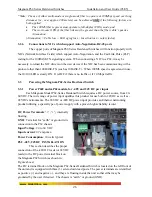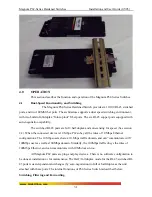
Magnum P62-Series Hardened Switches Installation and User Guide (05/05)
16
www GarrettCom com
.
.
have their packet buffer storage space divided evenly across all ports, resulting in a small, fixed
number of packets to be stored per port. When the port buffer fills up, dropped packets result.)
This dynamic buffer allocation provides the capability for the maximum resources of the Magnum
P62-Series unit to be applied to all traffic loads, even when the traffic activity is unbalanced
across the ports. Since the traffic on an operating network is constantly varying in packet density
per port and in aggregate density, the Magnum P62-Series Hardened Switches are constantly
adapting internally to provide maximum network performance with the least dropped packets.
When the P62-Series Switch detects that its free buffer queue space is low, the Switch
sends industry standard (full-duplex only) PAUSE packets out to the devices sending packets to
cause “flow control”. This tells the sending devices to temporarily stop sending traffic, which
allows a traffic catch-up to occur without dropping packets. Then, normal packet buffering and
processing resumes. This flow-control sequence occurs in a small fraction of a second and is
transparent to an observer. See Section 4.6 for additional details.
Another feature implemented in Magnum P62-Series Hardened Ethernet Switches is a
collision-based flow-control mechanism (when operating at half-duplex only). When the Switch
detects that its free buffer queue space is low, the Hardened Switch prevents more frames from
entering by forcing a collision signal on all receiving RJ-45 half-duplex ports in order to stop
incoming traffic.
The latency (the time the frame spends in the Hardened Switch before it is sent along or
forwarded to its destination) of the P62-Series Hardened Ethernet Switch varies with the port-
speed types, and the length of the frame is a variable here, as it is with all store-and-forward
switches. For 10 Mb-to-10 Mb or 10 Mb-to-100Mb or 100Mb-to-10 Mb forwarding, the latency
is 15 microseconds plus the packet time at 10Mb. For 100Mb-to-100Mb forwarding, the latency
is 5 microseconds plus the packet time at 100Mb.
















































